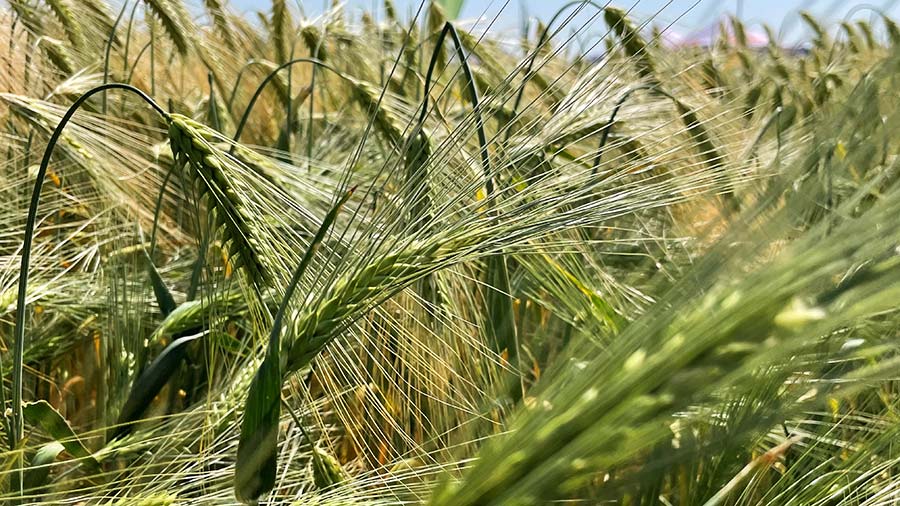What the new winter barley varieties offer for 2023-24
 New hybrid winter barley, Nephin © MAG/Richard Allison
New hybrid winter barley, Nephin © MAG/Richard Allison A two-row malting variety, a pair of two-row feed types and yet another six-row hybrid are the winter barley newcomers to consider this summer, ahead of autumn plantings.
Most of the attention is on feed variety Caravelle, which has taken top spot for yield among the two-rows and is being seen as a step up in the winter barley variety line-up.
With a UK treated yield of 106% – and 109% in the East – it also has a very good specific weight of 71.8kg/hl.
This will make it attractive to those who feed on-farm as well as those who are looking to increase production.
See also: How new tech aims to improve soil carbon measurement
New two-row feeds
“Caravelle is a welcome addition and is further proof that the two-row feed varieties can give the hybrids a run for their money,” says Sarah-Jane Osborne, AHDB’s field trials manager.
As a new high-yielding choice with a good untreated yield too, Caravelle will come in over time, believes Duncan Durno, arable technical manager at Openfield, although he reserves final judgement on its farm performance until he has seen more of it.
The other new two-row feed variety, Bolivia from Agrii, is only just behind on yield and specific weight.
It has a good agronomic package, including a very high brown rust rating, and is expected to appeal.
“These are both good additions to the list and should be compared to current choices,” says Sarah-Jane.
New malting choice
Otherwise, Buccaneer from Saaten Union – the first new winter malting variety for five years – now heads the malting category.
It has been granted provisional approval 1 for brewing use by the Malting Barley Committee.
Higher yielding than either of the Syngenta incumbents, Electrum and Craft, it has a treated yield of 100% and an untreated yield of 87%, putting it at the top of the table.
“As with all malting types, testing takes several years and continues after varieties have been added to the list. So we await the results from Buccaneer with interest,” says Sarah-Jane.
At this stage, Buccaneer appears to be later to mature than the other malting types, but has good agronomics, including a rhynchosporium resistance rating of 7.
“Of course, growers should always check that they have an end-user outlet before committing to varieties that have not completed testing or received full approval,” she says.
Existing varieties
Most of the winter malting barley grown in England is Craft, which has a 44% market share, continues Sarah-Jane.
“Its early maturity is valued but it does have yield lag compared to Buccaneer.”
The existing two-row feed varieties, Bolton, Tardis and Bordeaux, all have a UK treated yield of 103% and are on 105% in the East.
“Lightning, which was new last year, is right up there too,” Sarah-Jane reveals. “It also has a high untreated yield and a very welcome 8 for brown rust.”
Tardis has 40% market share and is expected to remain the top selling winter barley, adds Duncan.
“It stands very well and has good grain quality – we expect it to be in demand again this year.”
Bolton also took market share and is Duncan’s pick for sites with thinner soils. “There are some very good winter barley varieties on the market now.”
Others include Hawking and Orwell, although the latter is very susceptible to mildew, and Valerie, which is the only recommended variety to have resistance to both strains of barley yellow mosaic virus, as well as early maturity.
Mountain, which was recommended in 2019, is a high-yielding type but slightly weaker strawed, while Dazzle has good resistance to brown rust and rhynchosporium, but a slightly lower specific weight.
Hybrids
The decision on whether to grow a six-row hybrid or a two-row conventional winter barley variety comes down to site selection and grassweed pressure, advises Duncan.
“The performance gap between them has narrowed,” he says.
“Hybrids give more flexibility with drilling date and have proved to be competitive against blackgrass and very consistent. But I’m not sure that growers gain with them on traditional barley land.”
Knowing what value hybrids can bring is important as the seed will cost you an extra £40/ha, he adds.
The new hybrid winter barley for this year, Nephin, is in the same vein as some of its hybrid predecessors, offering very high yields and a good specific weight.
With the highest rhynchosporium resistance rating on the Recommended List, its soft spot appears to be brackling, at 16%.
Kingsbarn is the most popular hybrid, says Duncan, and there aren’t many reasons to move on from it.
That’s a view shared by Sarah-Jane, who suggests it’s the right choice for growers new to growing a hybrid.
“It responds better to plant growth regulators than some of the others.”
Otherwise, Belfry has the best straw characteristics of the hybrids, along with a treated yield of 104%. “It has remained popular for this reason.”
Feeris, a six-row feed variety, brings barley yellow dwarf virus tolerance, which is bound to appeal after a bad season for the disease and the introduction of the zero-insecticide action in the Sustainable Farming Incentive.
“There’s also a BYDV [barley yellow dwarf virus] tolerant hybrid coming along,” says Sarah-Jane.
Candidates
A six-row malting variety and eight feed varieties – not all of which have achieved National Listing – are waiting in the wings and will be considered for recommendation later this year.
Demoisel, from Agrii, is the six-row under test for malting, while Capitol is the highest-yielding, two-row feed variety at this early stage.
Loona heads the hybrid candidates, on a UK yield of 108%, while Buzzard is the first hybrid six-row to offer BYDV tolerance.

